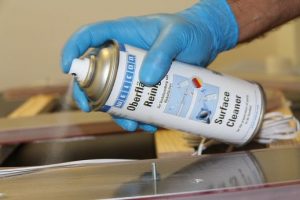The "all-purpose" fairytale
You can find it everywhere in advertising brochures and TV commercials: ALL-PURPOSE Glue.
As an inclined customer, the name suggests to me that I can glue anything together with these super products. For instance, a selected advertisement from a well-known manufacturer states: “The All-Purpose glue glues many materials together, quick and long-lasting.”
Yes…however, many materials are not “all” materials. And the name is “all-purpose glue”. There is usually additional information underneath that says: “…not suitable for styrofoam, PE, PP,…”. I repeat, the name is: “ALL-purpose glue”. I don’t intend to find fault here, these are all top quality adhesive products. But they aren’t all-purpose adhesives.
Adhesion
An adhesive that really can glue everything together can’t exist, from a purely chemical point of view. “Glueing” generally means bonding two surfaces with the help of an adhesive for as long as possible. Every surface has microscopically small indentations – no matter how smooth it seems to the human eye. The glue sets into these indentations and interlocks with the material. The technical term for this is adhesion.
On a superficial level one could say that the rougher the surface, the better the interlocking of the glue and its hold on the material. In addition, every material has a surface tension that influences how the glue is distributed over the surface. Metals generally have a good surface tension.
On the other hand, the surface tension of some plastics, like PE, PP, or PTFE, is very low and the glue can’t bond with the surface properly.
Cohesion
The glue also has an internal strength, which is called cohesion. It represents how hard the glue gets when it has dried. Many glues become so hard and have such a good interlocking effect with the glued material that it is more likely that the material will break than the glue.
The surface determines which glue to select
There are thousands of different materials in the world that can be glued together today. All of these materials have their own surface structure. For instance, PTFE is extremely smooth compared to polished steel.
That’s why there can’t be one glue for everything, because a thick glue penetrates very well into rough surface indentations but not so good into finer surfaces. Very runny glues may flow easily into every little crack, but they may be too runny for large indentations and absorbent surfaces, such as wood. There are also glues that require a metal contact in order for the reaction (hardening) to take place.
This poses a problem, for instance when two plastics are glued together. Plastics are generally very difficult to glue together. However, there are special adhesion solutions for almost every area – but there is no single glue that can actually glue all materials together.
Pre-treating the surfaces
As mentioned above, it is good for adhesion if the surface is rough in order to attain a good interlocking effect. That’s why it is usually a good idea to roughen up a surface before gluing.
However, it is always a good idea to clean the surfaces. In order to get good and long-lasting adhesion, both parts must be clean and grease-free. These instructions can usually be found on every tube of glue, no matter its purpose or who the manufacturer is.
Each particle of dirt that remains on the surface is also glued thereby separating the glue from the actual material. When cleaning isn’t done properly or not at all, it is possible that the dirt will stick to the surface wonderfully, however the part that actually needs to be glued on won’t.
The glues advertised as all-purpose glues can glue very many materials together. Especially in the DIY area. But no glue in the world can glue everything.
